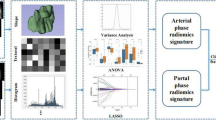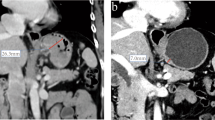Abstract
Purpose
To develop and evaluate a preoperative risk stratification model for predicting disease-free survival (DFS) based on contrast-enhanced multidetector computed tomography (ceMDCT) images in patients with gastric cancer (GC) undergoing radical surgery.
Methods
We retrospectively enrolled patients with GC who underwent ceMDCT followed by radical surgery. A preoperative risk stratification model was constructed (including risk factor selection, risk status scoring, and risk level assignment) using Cox proportional hazard regression and log-rank analyses in the training cohort; the model was tested in the validation cohort. A nomogram was used to compare the preoperative risk stratification model with a postoperative DFS prediction model.
Results
A total of 462 patients (training/validation: 271/191) were included. The ceMDCT features of T category (score of 0 or 2), N category (0, 1, 2, or 3), extramural vessel invasion (0 or 2), and tumor location (0 or 1) were selected to construct the preoperative risk stratification model, with 4 risk levels defined based on risk score. There were significant differences in DFS among the risk levels in both cohorts (p < 0.001). The predictive value of the preoperative model was similar to that of the postoperative model, with concordance indices of 0.791 (95% CI, 0.743–0.837) and 0.739 (95% CI, 0.666–0.812), respectively, in the training cohort and 0.762 (95% CI, 0.696–0.828) and 0.738 (95% CI, 0.684–0.792), respectively, in the validation cohort.
Conclusion
A preoperative risk stratification model based on ceMDCT images could be used to predict DFS and thus classify GC cases into various risk levels.




Similar content being viewed by others
References
Bu, Z., J. Ji (2013) A current view of gastric cancer in China. Translational Gastrointestinal Cancer 1–4.
Ychou, M., et al., Perioperative chemotherapy compared with surgery alone for resectable gastroesophageal adenocarcinoma: an FNCLCC and FFCD multicenter phase III trial. J Clin Oncol, 2011. 29(13): p. 1715-1721.
Cunningham, D., et al., Perioperative chemotherapy versus surgery alone for resectable gastroesophageal cancer. N Engl J Med, 2006. 355(1): p. 11-20.
National Comprehensive Cancer Network. Gastric Cancer, Version 2019. . 2019 March 14, 2020]; Available from: https://www.nccn.org/professionals/physician_gls/pdf/gastric.pdf.
Smyth, E.C., et al., Gastric cancer: ESMO Clinical Practice Guidelines for diagnosis, treatment and follow-up. Ann Oncol, 2016. 27(suppl 5): p. v38-v49.
Wang, F.H., et al., The Chinese Society of Clinical Oncology (CSCO): clinical guidelines for the diagnosis and treatment of gastric cancer. Cancer Commun (Lond), 2019. 39(1): p. 10.
Japanese Gastric Cancer Association, Japanese gastric cancer treatment guidelines 2014 (ver. 4). Gastric Cancer, 2017. 20(1): p. 1-19.
Bando, E., et al., Validation of the prognostic impact of the new tumor-node-metastasis clinical staging in patients with gastric cancer. Gastric Cancer, 2019. 22(1): p. 123-129.
Reddavid, R., et al., Neoadjuvant chemotherapy for gastric cancer. Is it a must or a fake? World J Gastroenterol, 2018. 24(2): p. 274-289.
Park, S., et al., Prospective Evaluation of Changes in Tumor Size and Tumor Metabolism in Patients with Advanced Gastric Cancer Undergoing Chemotherapy: Association and Clinical Implication. J Nucl Med, 2017. 58(6): p. 899-904.
Cheng, J., et al., CT-Detected Extramural Vessel Invasion and Regional Lymph Node Involvement in Stage T4a Gastric Cancer for Predicting Progression-Free Survival. AJR Am J Roentgenol, 2019: p. 1-7.
Huang, J.Y., et al., Borrmann type IV gastric cancer should be classified as pT4b disease. J Surg Res, 2016. 203(2): p. 258-67.
Smith, N.J., et al., Prognostic significance of magnetic resonance imaging-detected extramural vascular invasion in rectal cancer. Br J Surg, 2008. 95(2): p. 229-36.
An, J.Y., et al., Borrmann type IV: an independent prognostic factor for survival in gastric cancer. J Gastrointest Surg, 2008. 12(8): p. 1364-9.
Kim, T.U., et al., Prognostic Value of Computed Tomography-Detected Extramural Venous Invasion to Predict Disease-Free Survival in Patients With Gastric Cancer. J Comput Assist Tomogr, 2016. 41(3): p. 430.
Iasonos, A., et al., How to build and interpret a nomogram for cancer prognosis. J Clin Oncol, 2008. 26(8): p. 1364-1370.
Amin, M.B., et al., AJCC Cancer Staging Manual, 8th ed. 2017, Chicago, IL: American College of Surgeons.
De Manzoni, G., et al., The Italian Research Group for Gastric Cancer (GIRCG) guidelines for gastric cancer staging and treatment: 2015. Gastric Cancer, 2017. 20(1): p. 20-30.
Seevaratnam, R., et al., How useful is preoperative imaging for tumor, node, metastasis (TNM) staging of gastric cancer? A meta-analysis. Gastric Cancer, 2012. 15(1): p. S3-S18.
Tan, C.H., et al., Extramural venous invasion by gastrointestinal malignancies: CT appearances. Abdom Imaging, 2011. 36(5): p. 491-502.
Shah, M.A., et al., Molecular classification of gastric cancer: a new paradigm. Clin Cancer Res, 2011. 17(9): p. 2693-2701.
Yan, C., et al., Preoperative Gross Classification of Gastric Adenocarcinoma: Comparison of Double Contrast-Enhanced Ultrasound and Multi-Detector Row CT. Ultrasound Med Biol, 2016. 42(7): p. 1431-40.
Alatengbaolide, et al., Lymph node ratio is an independent prognostic factor in gastric cancer after curative resection (R0) regardless of the examined number of lymph nodes. Am J Clin Oncol, 2013. 36(4): p. 325-330.
Feng, F., et al., Prognostic value of differentiation status in gastric cancer. BMC Cancer, 2018. 18(1): p. 865.
von Rahden, B.H., et al., Lymphatic vessel invasion as a prognostic factor in patients with primary resected adenocarcinomas of the esophagogastric junction. J Clin Oncol, 2005. 23(4): p. 874-879.
Saito, H., et al., Macroscopic tumor size as a simple prognostic indicator in patients with gastric cancer. Am J Surg, 2006. 192(3): p. 296-300.
Sullivan, L.M., J.M. Massaro, and R.B. D'Agostino, Sr, Presentation of multivariate data for clinical use: The Framingham Study risk score functions. Stat Med, 2004. 23(10): p. 1631-60.
Landis, J.R. and G.G. Koch, The measurement of observer agreement for categorical data. Biometrics, 1977. 33: p. 159-174.
Battersby, N.J., et al., Prospective Validation of a Low Rectal Cancer Magnetic Resonance Imaging Staging System and Development of a Local Recurrence Risk Stratification Model: The MERCURY II Study. Ann Surg, 2016. 263(4): p. 751-60.
Giganti, F., et al., Preoperative locoregional staging of gastric cancer: is there a place for magnetic resonance imaging? Prospective comparison with EUS and multidetector computed tomography. Gastric Cancer, 2015. 19(1): p. 216-225.
Cheng, J., et al., The prognostic significance of extramural venous invasion detected by multiple-row detector computed tomography in stage III gastric cancer. Abdominal Radiology, 2016. 41(7): p. 1219-1226.
Hirabayashi, S., et al., Development and external validation of a nomogram for overall survival after curative resection in serosa-negative, locally advanced gastric cancer. Ann Oncol, 2014. 25(6): p. 1179-84.
Park, C.J., et al., Prognostic significance of preoperative CT findings in patients with advanced gastric cancer who underwent curative gastrectomy. PLoS One, 2018. 13(8): p. e0202207.
Li, W., et al., Prognostic value of computed tomography radiomics features in patients with gastric cancer following curative resection. Eur Radiol, 2018.
Zhang, W., et al., Development and validation of a CT-based radiomic nomogram for preoperative prediction of early recurrence in advanced gastric cancer. Radiother Oncol, 2020. 145: p. 13-20.
Li, J., et al., Intratumoral and Peritumoral Radiomics of Contrast-Enhanced CT for Prediction of Disease-Free Survival and Chemotherapy Response in Stage II/III Gastric Cancer. Front Oncol, 2020. 10: p. 552270.
Zhang, L., et al., A deep learning risk prediction model for overall survival in patients with gastric cancer: A multicenter study. Radiother Oncol, 2020. 150: p. 73-80.
Jiang, Y., et al., Radiomics signature of computed tomography imaging for prediction of survival and chemotherapeutic benefits in gastric cancer. EBioMedicine, 2018. 36: p. 171-182.
Han, D.-S., et al., Nomogram predicting long-term survival after d2 gastrectomy for gastric cancer. J Clin Oncol, 2012. 30(31): p. 3834-3840.
Kattan, M.W., et al., Postoperative nomogram for disease-specific survival after an R0 resection for gastric carcinoma. J Clin Oncol, 2003. 21(19): p. 3647-3650.
Tan, P. and K.G. Yeoh, Genetics and Molecular Pathogenesis of Gastric Adenocarcinoma. Gastroenterology, 2015. 149(5): p. 1153-1162.e3.
Acknowledgements
We appreciate Xiaohua Zhou, Ph.D (azhou@bicmr.pku.edu.cn) for statistical consulting of this article. We also appreciate Ms. Megan Griffiths (megangriffiths97@gmail.com) for conducting a linguistic revision of this article.
Funding
This work was supported by the National Natural Science Foundation of China (Grant Number 81901819) and Peking University People's Hospital Research and Development Funds (RDX2019-01).
Author information
Authors and Affiliations
Contributions
CF Investigation, Methodology, Writing—Original draft preparation; JC Conceptualization, Original draft preparation, Methodology, Funding acquisition; ZX Methodology; YZ Investigation; YY, NH Supervision; YW Conceptualization, Writing—Reviewing and Editing.
Corresponding author
Ethics declarations
Conflict of interest
The authors declare no conflict of interest.
Ethical approval
This retrospective study was approved by our local institutional review boards, which waived the requirement for obtaining informed consent.
Additional information
Publisher's Note
Springer Nature remains neutral with regard to jurisdictional claims in published maps and institutional affiliations.
Rights and permissions
About this article
Cite this article
Feng, C., Cheng, J., Zeng, X. et al. Development and evaluation of a ceMDCT-based preoperative risk stratification model to predict disease-free survival after radical surgery in patients with gastric cancer. Abdom Radiol 46, 4079–4089 (2021). https://doi.org/10.1007/s00261-021-03049-0
Received:
Revised:
Accepted:
Published:
Issue Date:
DOI: https://doi.org/10.1007/s00261-021-03049-0




